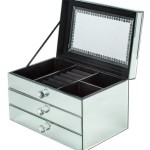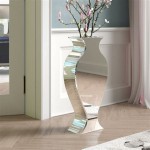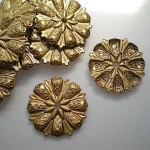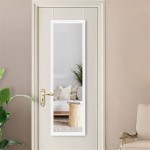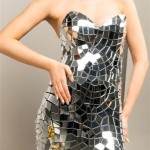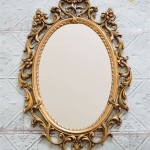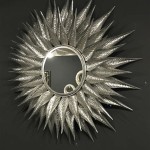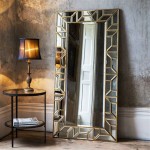Antique Etched Glass Wall Mirrors: A Reflection of History and Artistry
Antique etched glass wall mirrors offer a unique blend of functionality and artistry. These pieces, often originating from the late 19th and early 20th centuries, serve as captivating reflections of bygone eras. Their intricate designs and historical significance make them highly sought-after by collectors and interior design enthusiasts alike. Understanding the nuances of these mirrors, from their production techniques to their stylistic variations, allows for a deeper appreciation of their enduring appeal.
The Art of Etching Glass
Etching involves the use of acid to create intricate designs on the surface of glass. Before the advent of modern techniques, artisans used hydrofluoric acid, a highly corrosive substance, to achieve the desired effect. A protective layer of wax or resist was applied to the glass, and the design was meticulously carved through this layer. The exposed glass was then subjected to the acid, which etched the design into the surface. This labor-intensive process required great skill and precision, resulting in the unique and highly valued etched designs found on antique mirrors.
Popular Motifs and Styles
The imagery found on antique etched glass mirrors reflects the popular styles and motifs of their respective periods. Art Nouveau mirrors often feature flowing lines, floral patterns, and depictions of mythical creatures. Art Deco mirrors, on the other hand, showcase geometric shapes, stylized flora, and a more streamlined aesthetic. Victorian-era mirrors may incorporate intricate scrollwork, classical figures, and elaborate framing. Identifying these stylistic elements can help determine the age and origin of a particular mirror.
The Role of Framing in Antique Mirrors
The frame of an antique etched glass mirror is an integral part of its overall aesthetic and value. Frames were often crafted from high-quality materials such as carved wood, gilded plaster, or ornate metal. The style of the frame typically complements the etched design on the mirror itself. A well-preserved frame adds significantly to the mirror's beauty and historical significance, reflecting the craftsmanship of the period in which it was created.
Identifying Authentic Antique Etched Glass Mirrors
Distinguishing authentic antique mirrors from reproductions requires careful examination. Authentic antique mirrors often exhibit slight imperfections in the glass, such as bubbles or subtle variations in thickness. The etching itself may show signs of wear or patina, indicating age. Examining the back of the mirror can also provide clues; older mirrors typically have a different backing than modern reproductions. Consulting with a reputable antiques dealer or appraiser can offer further guidance in authentication.
Caring for Antique Etched Glass Mirrors
Proper care is essential to preserving the beauty and integrity of antique etched glass mirrors. Cleaning should be done with gentle, non-abrasive materials. Avoid using harsh chemicals or excessive moisture, as these can damage the delicate etched surface and the frame. When handling the mirror, support it from the back and avoid touching the etched surface directly. Storing the mirror in a stable, climate-controlled environment will help protect it from fluctuations in temperature and humidity, which can cause cracking or warping.
The Value of Antique Etched Glass Mirrors
The value of an antique etched glass mirror is determined by several factors, including its age, rarity, condition, and artistic merit. Mirrors with intricate designs, well-preserved frames, and documented provenance command higher prices. The size and overall quality of the mirror also play a role in its valuation. Consulting with an antiques appraiser is recommended for obtaining a professional assessment of a mirror's worth.
Incorporating Antique Etched Glass Mirrors in Modern Interiors
Antique etched glass mirrors can add a touch of elegance and history to a variety of interior design styles. They can serve as focal points in living rooms, dining rooms, and bedrooms. Their reflective surfaces can also enhance the brightness and perceived size of a space. When incorporating antique mirrors into a modern setting, consider the existing décor and choose a mirror that complements the overall aesthetic. Whether used as a standalone piece or as part of a larger collection, an antique etched glass mirror can elevate a room's ambiance and create a captivating visual statement.

Vintage Venetian Style Etched Glass Wall Mirror Ornate Beveled

Large Venetian Etched Glass Overmantel Wall Mirror 1880 For At Pamono

Vintage Venetian Style Etched Glass Wall Mirror Ornate Beveled

Vintage Nurre Wood Frame Etched Glass Wall Mirror W Gesso Gold Gilt Flowers

Olivier Fleury French Antiques Antique Mirrors For

Vintage Venetian Etched Glass Wall Mirror Chairish

Large Antique Wall Mirror Etched Glass 3 Panels Ornate

Etched Venetian Glass Wall Mirror On Antique Row West Palm Beach Florida

Large Venetian Etched Glass Overmantel Wall Mirror 1880 For At Pamono

Vintage Venetian Etched Glass Wall Mirror Chairish

